 W
WThe Andean hairy armadillo is an armadillo found mainly in Bolivia, in the region of the Puna; the departments of Oruro, La Paz, and Cochabamba. Nowark (1991) describes it as distributed in Bolivia and northern Chile. A recent publication of Pacheco (1995) also locates the species in the Puno Region of Peru. This species is also thought to be present in northern Argentina. However, this location may actually only contain a population of C. vellerosus.
 W
WArmadillos meaning "little armoured ones" in Spanish are New World placental mammals in the order Cingulata. The Chlamyphoridae and Dasypodidae are the only surviving families in the order, which is part of the superorder Xenarthra, along with the anteaters and sloths. Nine extinct genera and 21 extant species of armadillo have been described, some of which are distinguished by the number of bands on their armour. All species are native to the Americas, where they inhabit a variety of different environments.
 W
WThe big hairy armadillo or large hairy armadillo or "enormous hairy armadillo"(Chaetophractus villosus) is one of the largest and most numerous armadillos in South America. It lives from sea level to altitudes of up to 1,300 meters across the southern portion of South America, and can be found in grasslands, forests, and savannahs, and has even started claiming agricultural areas as its home. It is an accomplished digger and spends most of its time below ground. It makes both temporary and long-term burrows, depending on its food source. The armadillo can use specially evolved membranes in its nose to obtain oxygen from the surrounding soil particles without inhaling any of the soil itself. Armadillos are protected from predators by a series of thin, bony plates along the head and back. They reach sexual maturity at around 9 months and have been known to live over 30 years in captivity. Though this animal is routinely harvested for its meat and its shell, or simply killed for pestering farmers, it has shown amazing resiliency, and populations seem to be handling this exploitation well. Currently, no protective practices are in place for this armadillo, but it does live in many protected areas. This species of armadillo is a preferred research animal due to its adaptability to laboratory settings, and relative hardiness in situations of stress.
 W
WThe Brazilian three-banded armadillo is an armadillo species endemic to eastern Brazil, where it is known as tatu-bola. It is one of only two species of armadillo that can roll into a ball. It has suffered a 30% decline in population in the last 10 years.
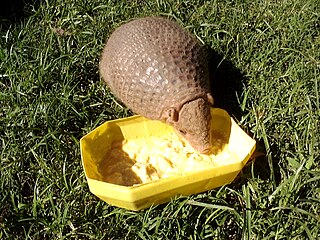 W
WCabassous is a genus of South and Central American armadillos. The name is the Latinised form of the Kalini word for "armadillo".
 W
WThe Chacoan naked-tailed armadillo is a species of South American armadillo.
 W
WChaetophractus is a small genus of armadillos in the family Chlamyphoridae. It contains the following three species:
 W
WChlamyphorinae is a subfamily of South American armadillos in the family Chlamyphoridae. Members of this subfamily, the fairy armadillos, are largely fossorial and have reduced eyes and robust forearms with large claws for digging.
 W
WDasypus is the only extant genus in the family Dasypodidae. Its species are known as long-nosed or naked-tailed armadillos. They are found in South, Central, and North America, as well as on the Caribbean islands of Grenada, Trinidad and Tobago. Members of Dasypus are solitary and primarily nocturnal to avoid temperature extremes and predation. They exist in numerous habitats ranging from brush to grassland areas and are mainly insectivorous.
 W
WDasypus bellus, the beautiful armadillo, is an extinct armadillo species endemic to North America and South America from the Pleistocene, living from 1.8 mya—11,000 years ago, existing for approximately 1.789 million years .
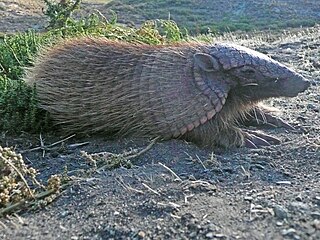 W
WEuphractinae is an armadillo subfamily in the family Chlamyphoridae.
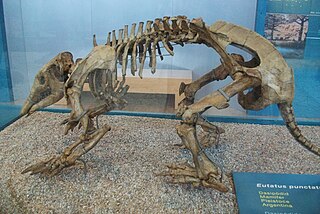 W
WEutatus is an extinct genus of large armadillos of the family Dasypodidae. It was endemic to South America from the Early Miocene to Late Pleistocene, living from 17.5 Ma-11,000 years ago, with possible survival into the early Holocene and existing for approximately 17.49 million years . Based on carbon isotope ratios, it is thought to have been an herbivore that fed on grasses.
 W
WThe giant armadillo, colloquially tatou, ocarro, tatu-canastra or tatú carreta, is the largest living species of armadillo. It lives in South America, ranging throughout as far south as northern Argentina. This species is considered vulnerable to extinction.
 W
WThe greater fairy armadillo, also known as Burmeister's armadillo or the Chacoan fairy armadillo, is a species of armadillo in the family Chlamyphoridae. It is found in Argentina, Bolivia, and Paraguay. Its natural habitats are subtropical or tropical dry shrubland and subtropical or tropical dry lowland grassland. It is threatened by habitat loss. It is the only species in the genus Calyptophractus.
 W
WThe greater long-nosed armadillo is a South American species of armadillo found in Colombia, Venezuela, Ecuador, Guyana, Suriname, French Guiana, Peru, Bolivia and Brazil. It is a solitary, nocturnal, terrestrial animal that feeds on arthropods and other invertebrates, usually living in the vicinity of streams and swamps.
 W
WThe greater naked-tailed armadillo is an armadillo species from South America.
 W
WThe hairy long-nosed armadillo, or woolly armadillo, is a species of armadillo in the family Dasypodidae. It is endemic to Peru. Its natural habitats are subtropical or tropical moist lowland forest and subtropical or tropical moist montane forest. The International Union for Conservation of Nature used to consider it a "vulnerable species" but has changed this assessment to "data deficient" because so little is known about the animal and the threats it faces.
 W
WThe Llanos long-nosed armadillo is a species of armadillo in the family Dasypodidae. It is endemic to Colombia and Venezuela, where its habitat is the intermittently flooded grassland of the Llanos. The species is closely related to the nine-banded armadillo and the great long-nosed armadillo. It has very little hair and can weigh up to 22 pounds (9.5 kg), and can grow to about 2.1 feet (60 cm) long. It lives in dense cover near limestone formations. Like most other armadillos, it eats ants.
 W
WThe nine-banded armadillo, or the nine-banded, long-nosed armadillo, is a medium-sized mammal found in North, Central, and South America, making it the most widespread of the armadillos. Its ancestors originated in South America, and remained there until the formation of the Isthmus of Panama allowed them to enter North America as part of the Great American Interchange. The nine-banded armadillo is a solitary, mainly nocturnal animal, found in many kinds of habitats, from mature and secondary rainforests to grassland and dry scrub. It is an insectivore, feeding chiefly on ants, termites, and other small invertebrates. The armadillo can jump 3–4 ft (91–122 cm) straight in the air if sufficiently frightened, making it a particular danger on roads. It is the state small mammal of Texas.
 W
WThe northern naked-tailed armadillo is a species of armadillo. It is one of only two species of armadillo found outside of South America, the other being the more widely distributed nine-banded armadillo.
 W
WThe pichi, dwarf armadillo or pygmy armadillo is an armadillo native to Argentina and Chile. It is the only living member of the genus Zaedyus, and the only armadillo to hibernate.
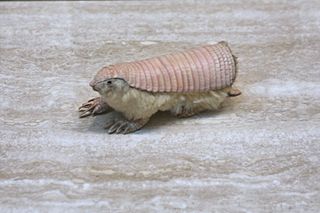 W
WThe pink fairy armadillo or pichiciego is the smallest species of armadillo, first described by Richard Harlan in 1825. This solitary, desert-adapted animal is endemic to central Argentina and can be found inhabiting sandy plains, dunes, and scrubby grasslands.
 W
WThe screaming hairy armadillo is a species of armadillo also known as the small screaming armadillo, crying armadillo or the small hairy armadillo. It is a burrowing armadillo found in the central and southern parts of South America. The adjective "screaming" derives from its habit of squealing when handled.
 W
WThe seven-banded, long-nosed armadillo or just seven-banded armadillo, Dasypus septemcinctus, is a species of armadillo from South America found in Paraguay, Argentina, Bolivia and Brazil. It is a solitary nocturnal, terrestrial animal, living mostly in dry habitats, outside of rainforest regions.
 W
WThe six-banded armadillo, also known as the yellow armadillo, is an armadillo found in South America. The sole extant member of its genus, it was first described by Swedish zoologist Carl Linnaeus in 1758. The six-banded armadillo is typically between 40 and 50 centimeters in head-and-body length, and weighs 3.2 to 6.5 kilograms. The carapace is pale yellow to reddish brown, marked by scales of equal length, and scantily covered by buff to white bristle-like hairs. The forefeet have five distinct toes, each with moderately developed claws.
 W
WThe southern long-nosed armadillo is a species of armadillo native to South America.
 W
WThe southern naked-tailed armadillo is a species of small armadillo from South America.
 W
WThe southern three-banded armadillo, also called the Bolivian three-banded armadillo, is an armadillo species from South America. It is found in parts of northern Argentina, southwestern Brazil, Paraguay and Bolivia, at elevations from sea level to 770 m (2,530 ft).
 W
WStegotherium is an extinct genus of armadillo in the family Dasypodidae from Early Miocene Argentina.
 W
WThe genus Tolypeutes contains the two species of three-banded armadillos. They are restricted to open and semi-open habitats in South America.
 W
WTolypeutinae is a subfamily of armadillos in the family Chlamyphoridae, consisting of the giant, three-banded and naked-tailed armadillos.
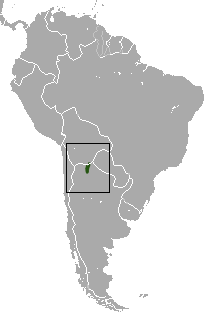 W
WYepes's mulita or Yunga's lesser long-nosed armadillo is a species of armadillo in the family Dasypodidae. It is endemic to Argentina and Bolivia. Its natural habitat is subtropical dry forests. The species was renamed D. yepesi because the type of D. mazzai was suspected to correspond of other species of Dasypus, which it was later proved wrong, becoming D. yepesi a synonym of D. mazzai.